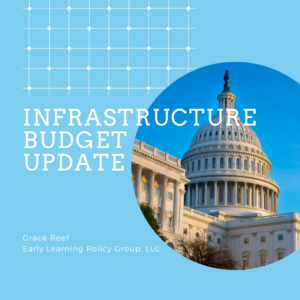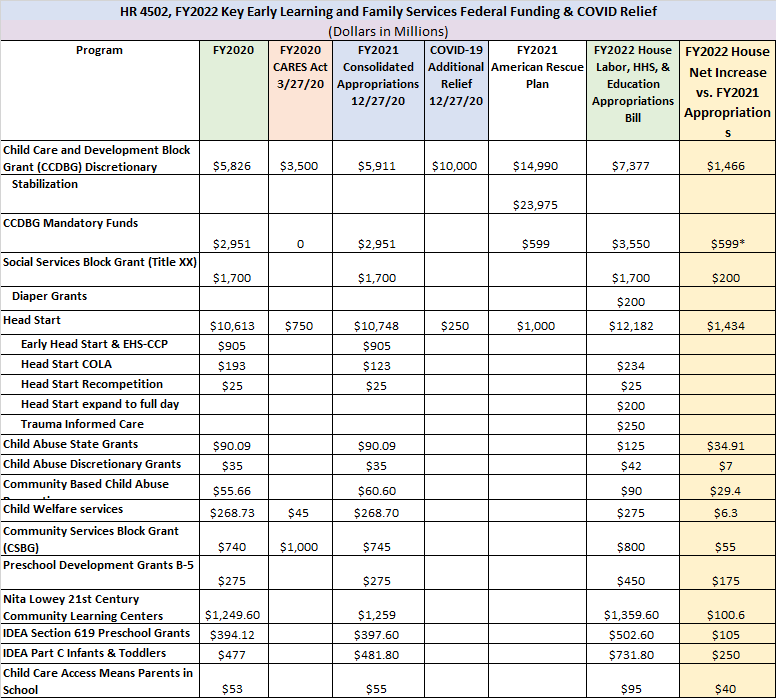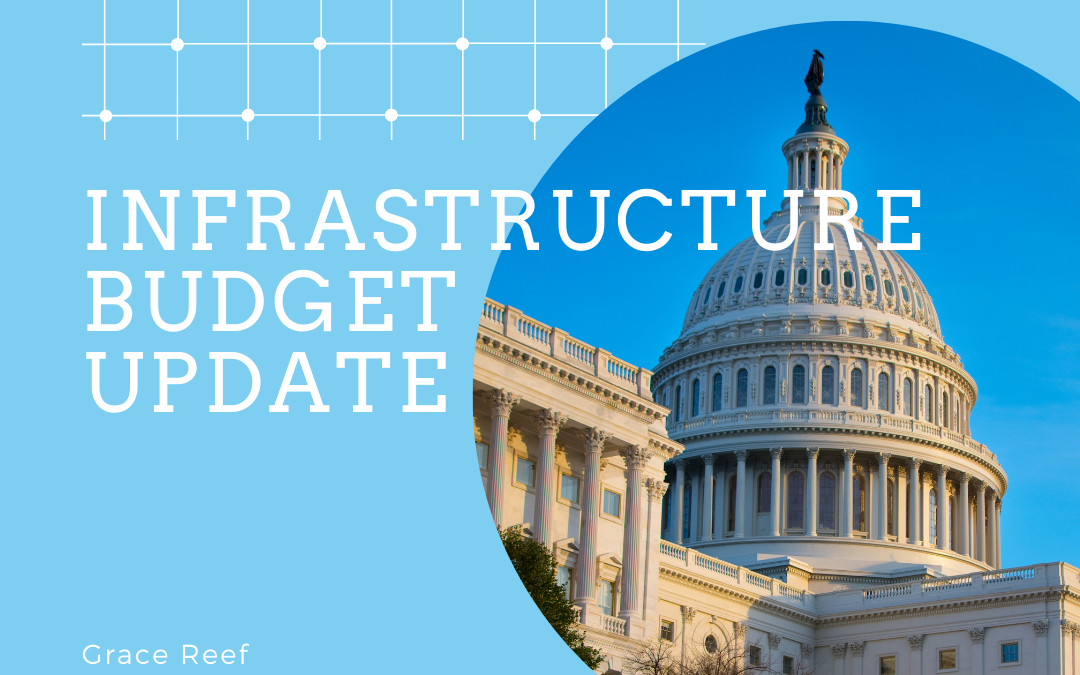 Where are we in the federal budget process?
Where are we in the federal budget process?
It’s complicated. Let’s start with what is known for certain. Fiscal year 2021 ends September 30, which means that either Congress needs to approve annual appropriations bills for FY2022 before September 30 or enact an extension – a continuing resolution for some period of time (e.g., a few weeks, a few months, etc.). The House passed its version of the FY2022 Labor, HHS, and Education Appropriations bill on July 29 by a party-line vote of 219-207. More on that below. The Senate Appropriations Committee is not expected to work on its version of this bill until sometime in the fall.
There’s lots of news about an infrastructure bill and some big $3.5 trillion package. What about those bills? How are they related (or not)?
In the spring, President Biden proposed an infrastructure package (traditionally roads, bridges, etc.) and a care-giving investment package (e.g., it is this second package that could potentially contain funding for child care and preschool). The President proposed $225 billion for child care and $200 billion for universal preschool. There has been lots of discussion about the size of these packages and how they would be paid for (and also the content).
At this point, a bipartisan group in the Senate has come to agreement on a 10-year $1.2 trillion infrastructure bill ($550 billion in new spending for traditional road, bridge, and other infrastructure investments). This bill is called the Infrastructure Investment and Jobs Act and the text of the bill was released yesterday – more than 2,700 pages. Senators are now reviewing it and the measure is expected to be debated on the Senate floor this week. Majority Leader Schumer has predicted it will pass late this week (although with 2,700 pages, anything could happen).
In order for the second package, the care-giving investment package to move forward, if it is to move forward, the Senate needs to pass a budget resolution, which would include instructions for a reconciliation bill. As a reminder, the budget resolution doesn’t need to become law. It’s an internal management guide or blueprint for Congress to follow that sets budget targets and limits. Part of the blueprint includes reconciliation instructions – which in general means instructions for a level of spending and saving that is achieved by committees and bundled together in a bill called “reconciliation”. The reconciliation bill has special rules – it can’t be filibustered, amendments must be germane, and provisions are subject to terms and conditions (i.e., it’s not an authorizing bill that can create new programs). The reconciliation bill is important because it will be the vehicle for the 2nd care-giving package. The reconciliation bill is needed because it appears that Republicans are likely to oppose the budget resolution and also the reconciliation bill (i.e., both the budget resolution and reconciliation bill will pass with 51 votes- with the Vice President breaking a 50-50 tie).
The budget resolution (which carries reconciliation instructions) could pass the Senate potentially the week of August 9. Majority Leader Schumer has said he wants to pass the infrastructure bill this week and the budget resolution next week. If the infrastructure bill passes, the road is clear to consider the budget resolution. However, it’s a bit unclear about the spending level that will be included in the budget resolution. Senate Budget Chairman Sanders is pushing for $3.5 trillion. Some moderate Senate Democrats are saying that they can’t support spending at that level. It’s unclear whether the level of spending in the budget resolution will be reduced in order to garner the 50 votes to pass or whether it will pass at $3.5 trillion with some fuzzy offsets to be determined later. The measure is a blueprint, so it is unlikely to include details. What is certain is that the bill will need to be supported by all 50 Democrats since Republicans are likely to oppose it.
Majority Leader Schumer has said he wants to pass both bills (the infrastructure package and the budget resolution) before the Senate adjourns for the August recess (likely sometime the week of August 9th). The first task is passing the infrastructure bill. The second is passing the budget resolution.
What about the House? What is the House expected to do on infrastructure and the budget resolution?
The House adjourned Friday. At this point, the House is waiting to see what the Senate will do/pass. It is possible that the House leadership could call members back to session to consider one or both bills. Or, the House could wait to see what the Senate does and then confer with members to consider legislation after Labor Day when Congress reconvenes.
What is clear is that if the Senate passes both bills, then they will be sent to the House. What will be the order in which the bills are considered in the House? Unclear. It could be that the House first considers the budget resolution (i.e., under a strategy that envisions no vote on the infrastructure bill until the budget resolution is passed). The House Blue Dogs and House Bipartisan Problem Solvers group are pressing on the Speaker to consider the infrastructure bill first and not hold it hostage to the passage of the budget resolution.
Will the House amend the infrastructure bill? Or the budget resolution? Unclear. But, if they do, the measures would have to go back to the Senate for passage (if altered). Prospects on that? Unclear. Just as in the Senate, the progressives want a $3.5 trillion budget resolution and more moderate Democrats want a lower level of spending. Therefore, at this point, all eyes are on the Senate before the House determines floor strategy for passage.
Where do the FY2022 appropriations bills fit in? Are they connected to the infrastructure bill or budget resolution?
It’s unclear what will happen in the fall. While the House has passed it’s FY2022 Labor, HHS, Education bill (with funding increases described below for early learning programs), a budget resolution could alter the top-level spending allowed for FY2022. Spending could be higher or lower. What is likely is that there will be some level of budget negotiations in the fall that will set spending for FY2022 and beyond utilizing annual appropriations bills (or a continuing resolution) as well as a reconciliation bill (that could increase investments significantly through offsets such as taxes on individuals earning more than $400,000 or recouping unobligated COVID funding to some extent from some yet to be named accounts). For example, unused unemployment compensation funding.
So, are there big increases for early learning programs in the House-passed FY2022 Labor, HHS, and Education Appropriations bill? How would child care and preschool be expanded?
Pre-COVID, the increases in the FY2022 annual appropriations bill for early learning would have been seen as large. They are large, but not huge compared to the $53 billion increase in supplemental child care funding provided in the CARES Act, the CRSSA COVID Relief bill (December 2020), and the American Rescue Plan in the past 16 months. See the House passed increases for early learning programs provided in the FY2022 annual appropriations bill below highlighted in yellow. For consideration of President Biden’s $225 billion for child care and $200 billion for universal preschool, passage of a reconciliation bill will be needed (where such investments would be included to the extent the bill moves forward). Unlike the budget resolution, which is an internal budget management guide (and does not need to become law), the reconciliation bill must be approved by the House and Senate and signed into law by the President.

So, the President’s child care and preschool proposals would be included in the reconciliation bill somehow later in the fall?
Potentially, yes. The construct of reconciliation is a bit tricky. Basically, any child care and preschool provisions would need to conform to reconciliation rules in order for the Senate parliamentarian took their inclusion in the bill (e.g., remember – last year, the Senate parliamentarian ruled that increasing the minimum wage could not be included in reconciliation). What does this mean? It means that the sponsors of the major child care bills are reviewing their language, potentially coming up with options on how their proposals can be structured, running those options by the Congressional Budget Office to see what various options might cost, and otherwise trying to figure out how they can make adjustments depending upon what level of spending is allowed under reconciliation (and how child care and preschool spending fit under that level). For example, related to preschool – it is unlikely the reconciliation rules would allow for the creation of a new program, so how could a preschool expansion initiative be included? Maybe through CCDBG. Maybe through PDG B-5. It’s unclear, but in general, staff are coming up with various options so that when negotiations begin on reconciliation in earnest later this fall, those involved with child care and preschool will be ready. They likely won’t be calling the shots, but have to live within the shots.
What’s the bottom line?
It’s likely to be a busy fall. In odd-numbered years, Congress has historically been in session until Thanksgiving or Christmas. Expect the same this year.
Additional Resources
- HHS, Office of Child Care American Rescue Plan Supplemental CCDBG Discretionary Fund Guidance, CCDF-ACF-IM-2021-03 (June 11, 2021)
- HHS, Office of Child Care American Rescue Plan Stabilization Grant Guidance, CCDF-ACF-IM-2021-02 (May 10, 2021)
- HHS, Coronavirus Response and Relief Supplemental Appropriations (CRRSA) Information Memorandum, CCDF-ACF-IM-2021-01 (April 14, 2021)

